Abstract
Qualitative spatial reasoning is an important function of the human brain. Artificial systems that can perform such reasoning have many applications such as Geographic Information Systems (GIS), robotics, biomedicine, and engineering. Automation of such analytical processes alleviates manual labor, and may increase the accuracy of the spatial assessments because the reasoning can be done objectively using 3D digital representations of the objects. Herein we introduce an algorithm to determine the spatial relation that exists between a pair of 3D objects when no a priori spatial knowledge is given. A second algorithm is presented to efficiently find the spatial relation that holds between each pair of objects in a set of 3D objects.
Access this chapter
Tax calculation will be finalised at checkout
Purchases are for personal use only
Preview
Unable to display preview. Download preview PDF.
References
Escrig, M.T., Toledo, F.: Qualitative spatial Reasoning: Theory and Practice: Application to Robot Navigation. IOS Press, Amsterdam (1998)
Cohn, A.G., Renz, J.: Qualitative Spatial Representation and Reasoning. In: Handbook of Knowledge Representation, pp. 551–596. Elsevier, Amsterdam (2008)
Albath, J., Leopold, J.L., Sabharwal, C.L., Maglia, A.M.: RCC-3D: Qualitative Spatial Reasoning in 3D. Submitted to Journal of Biomedical Semantics (2009)
Randell, D.A., Cui, Z., Cohn, A., Nebel, B., Rich, C., Swartout, W.: A spatial logic based on regions and connection. In: Proceedings of the Third International Conference on Principles of Knowledge Representation and Reasoning, KR 1992, pp. 165–176. Morgan Kaufmann, San Francisco (1992)
Wallgrün, J., Frommberger, L., Wolter, D., Dylla, F., Freksa, C.: Qualitative spatial representation and reasoning in the sparq-toolbox. In: Barkowsky, T., Knauff, M., Ligozat, G., Montello, D.R. (eds.) Spatial Cognition 2007. LNCS (LNAI), vol. 4387, pp. 39–58. Springer, Heidelberg (2007)
Apt, K.R., Brand, S.: Infinite Qualitative Simulations by Means of Constraint Programming. In: Benhamou, F. (ed.) CP 2006. LNCS, vol. 4204, pp. 29–43. Springer, Heidelberg (2006)
Duckham, M., Lingham, J., Mason, K., Worboys, M.: Qualitative Reasoning about Consistency in Geographic Information. Information Sciences 176(6), 601–627 (2006)
Ligozat, G., Renz, J.: What is a qualitative calculus? A general framework. In: Zhang, C., Guesgen, H.W., Yeap, W.-K. (eds.) PRICAI 2004. LNCS (LNAI), vol. 3157, pp. 53–64. Springer, Heidelberg (2004)
Li, S., Ying, M.: Generalized Region Connection Calculus. Artificial Intelligence 160(1-2), 1–34 (2004)
Gent, I., Miguel, I., Rendl, A.: Tailoring Solver-Independent Constraint Models: A Case Study with Essence’ and Minion. In: Miguel, I., Ruml, W. (eds.) SARA 2007. LNCS (LNAI), vol. 4612, pp. 184–199. Springer, Heidelberg (2007)
Egenhofer, M.J., Herring, J.: Categorizing binary topological relations between regions, lines, and points in geographic databases. NCGIA Technical Reports, 91-7 (1991)
Mouhoub, M.: Dynamic path consistency for interval-based temporal reasoning. In: Proceedings of the IASTED 21st International Conference on Artificial Intelligence and Applications. ACTA Press (2003)
Renz, J., Nebel, B.: Spatial Reasoning with Topological Information. In: Freksa, C., Habel, C., Wender, K.F. (eds.) Spatial Cognition 1998. LNCS (LNAI), vol. 1404, pp. 351–372. Springer, Heidelberg (1998)
Zygote Media Group: http://www.zygote.com
Author information
Authors and Affiliations
Editor information
Editors and Affiliations
Rights and permissions
Copyright information
© 2010 Springer-Verlag Berlin Heidelberg
About this paper
Cite this paper
Albath, J., Leopold, J.L., Sabharwal, C.L., Perry, K. (2010). Efficient Reasoning with RCC-3D. In: Bi, Y., Williams, MA. (eds) Knowledge Science, Engineering and Management. KSEM 2010. Lecture Notes in Computer Science(), vol 6291. Springer, Berlin, Heidelberg. https://doi.org/10.1007/978-3-642-15280-1_43
Download citation
DOI: https://doi.org/10.1007/978-3-642-15280-1_43
Publisher Name: Springer, Berlin, Heidelberg
Print ISBN: 978-3-642-15279-5
Online ISBN: 978-3-642-15280-1
eBook Packages: Computer ScienceComputer Science (R0)

